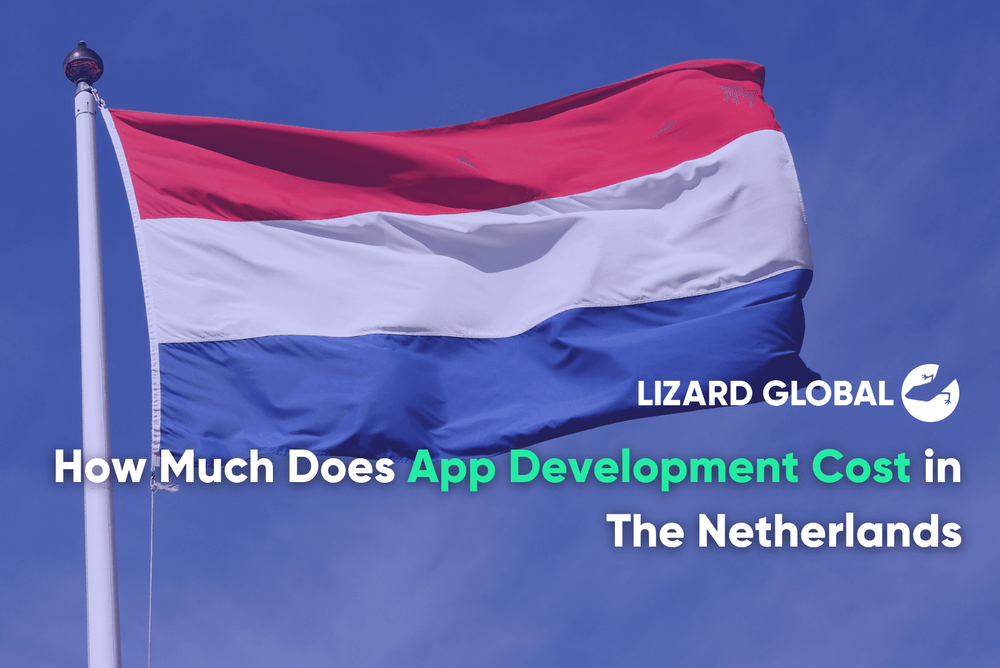What Is Gamification and How to Do It Right
Get the latest updates about our blog posts.
Subscribe so you don’t miss out!
Key Takeaways
- Gamification enhances engagement by incorporating game-like elements (points, badges, leaderboards) into non-gaming experiences
- Successful gamification aligns with clear objectives, whether it’s improving learning, increasing customer loyalty, or boosting workplace productivity
- Understanding your audience is key—design gamification mechanics that motivate users in a meaningful way
- Balance challenge and reward to keep users engaged without frustration or boredom
- Continuous optimization is crucial—analyze user behavior and tweak gamification elements based on data and feedback
Imagine logging into your favorite fitness app and being rewarded with a badge for completing your daily step goal. Or earning points for every lesson you complete in a language-learning app. These are examples of gamification—a strategy that integrates game-like elements into non-gaming environments to enhance user engagement and motivation.
From Duolingo’s streak system to Starbucks’ Rewards Program, businesses across industries leverage gamification to improve customer retention, employee productivity, and learning experiences. But how do you implement gamification the right way? Let’s break it down.
What Is Gamification?

Gamification is the process of integrating game-like mechanics into non-gaming environments to encourage user participation, engagement, and motivation. By leveraging elements such as points, leaderboards, badges, rewards, challenges, and progress tracking, gamification taps into human psychology—making everyday tasks more engaging and enjoyable.
The goal of gamification is to drive specific behaviors in users by making their interactions more interactive and rewarding. It is widely used in various industries, including education, healthcare, fitness, marketing, and workplace productivity.
Companies use gamification to encourage actions such as:
- Learning new skills (e.g., Duolingo, Khan Academy)
- Increasing customer loyalty (e.g., Starbucks Rewards, Nike Run Club)
- Boosting workplace productivity (e.g., Salesforce Trailhead)
When done correctly, gamification taps into intrinsic motivation, making tasks more enjoyable and rewarding.
How Gamification Works
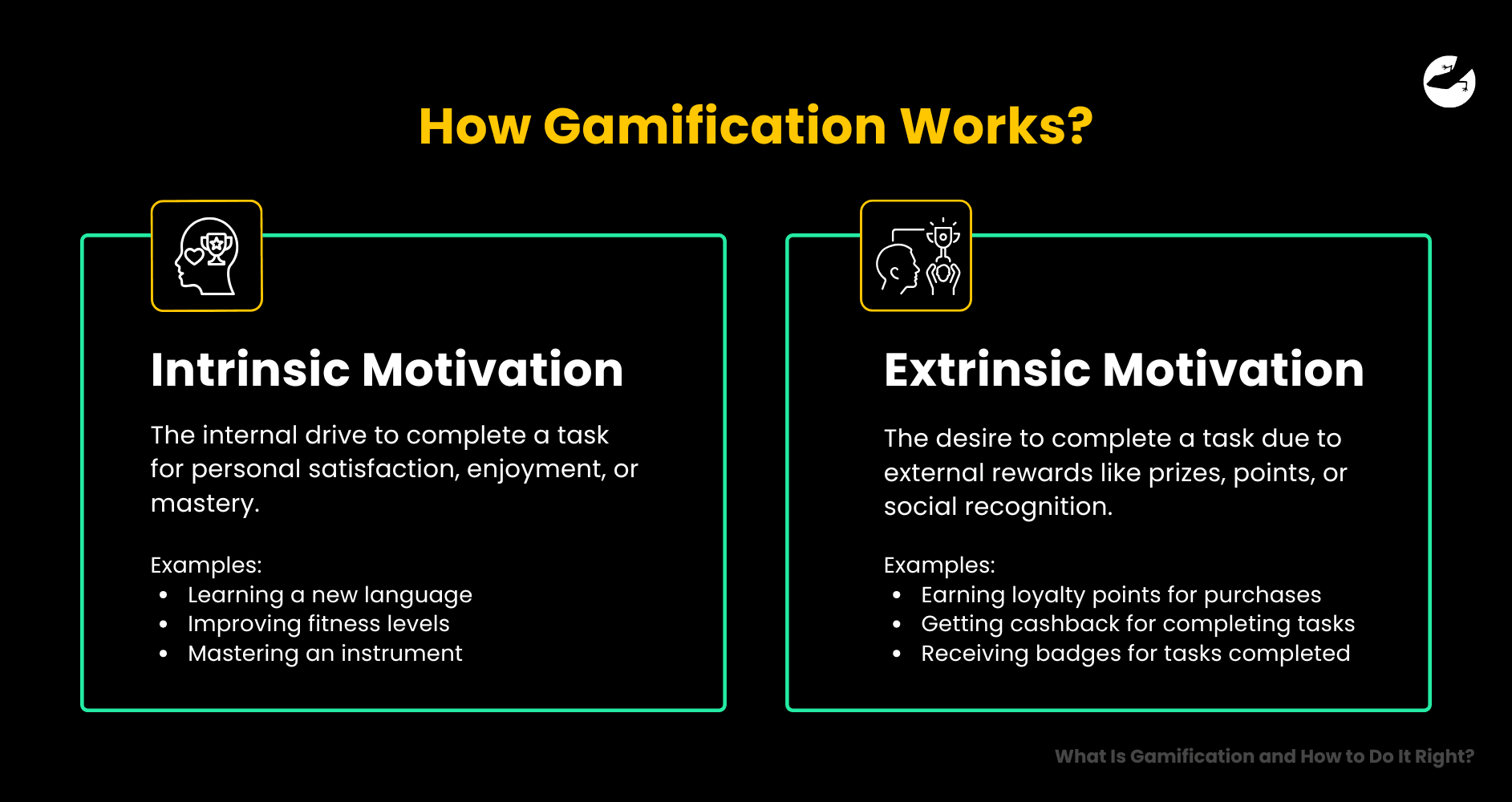
Gamification works by appealing to intrinsic and extrinsic motivation:
- Intrinsic motivation: The internal drive to complete a task for personal satisfaction, enjoyment, or mastery (e.g., learning a new language, improving fitness levels).
- Extrinsic motivation: The desire to complete a task due to external rewards like prizes, points, or social recognition (e.g., earning loyalty points for purchases).
By combining these motivations, gamification encourages users to engage with a product, system, or service more frequently and effectively.
Key Gamification Elements
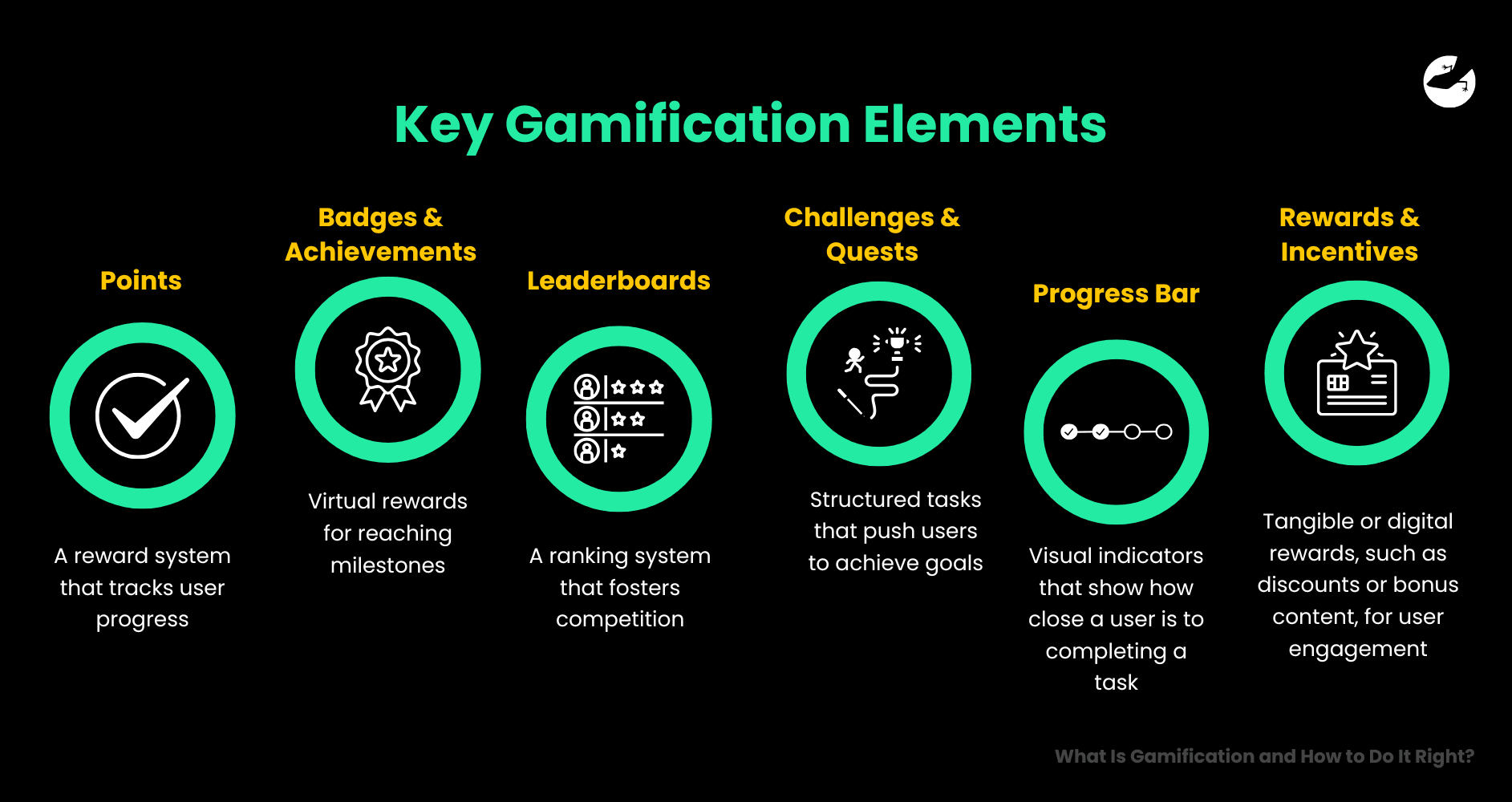
Gamification includes various game mechanics that influence user behavior:
- Points – A reward system that tracks user progress (e.g., collecting points for completing an online course).
- Badges & Achievements – Virtual rewards for reaching milestones (e.g., Duolingo’s badges for language proficiency).
- Leaderboards – A ranking system that fosters competition (e.g., Strava’s fitness challenge leaderboards).
- Challenges & Quests – Structured tasks that push users to achieve goals (e.g., Nike Run Club’s running challenges).
- Progress Bars – Visual indicators that show how close a user is to completing a task (e.g., LinkedIn’s profile completion bar).
- Rewards & Incentives – Tangible or digital rewards, such as discounts or bonus content, for user engagement (e.g., Starbucks Rewards program).
Want to find out how much it costs to build your dream app or web app?
Examples of Gamification
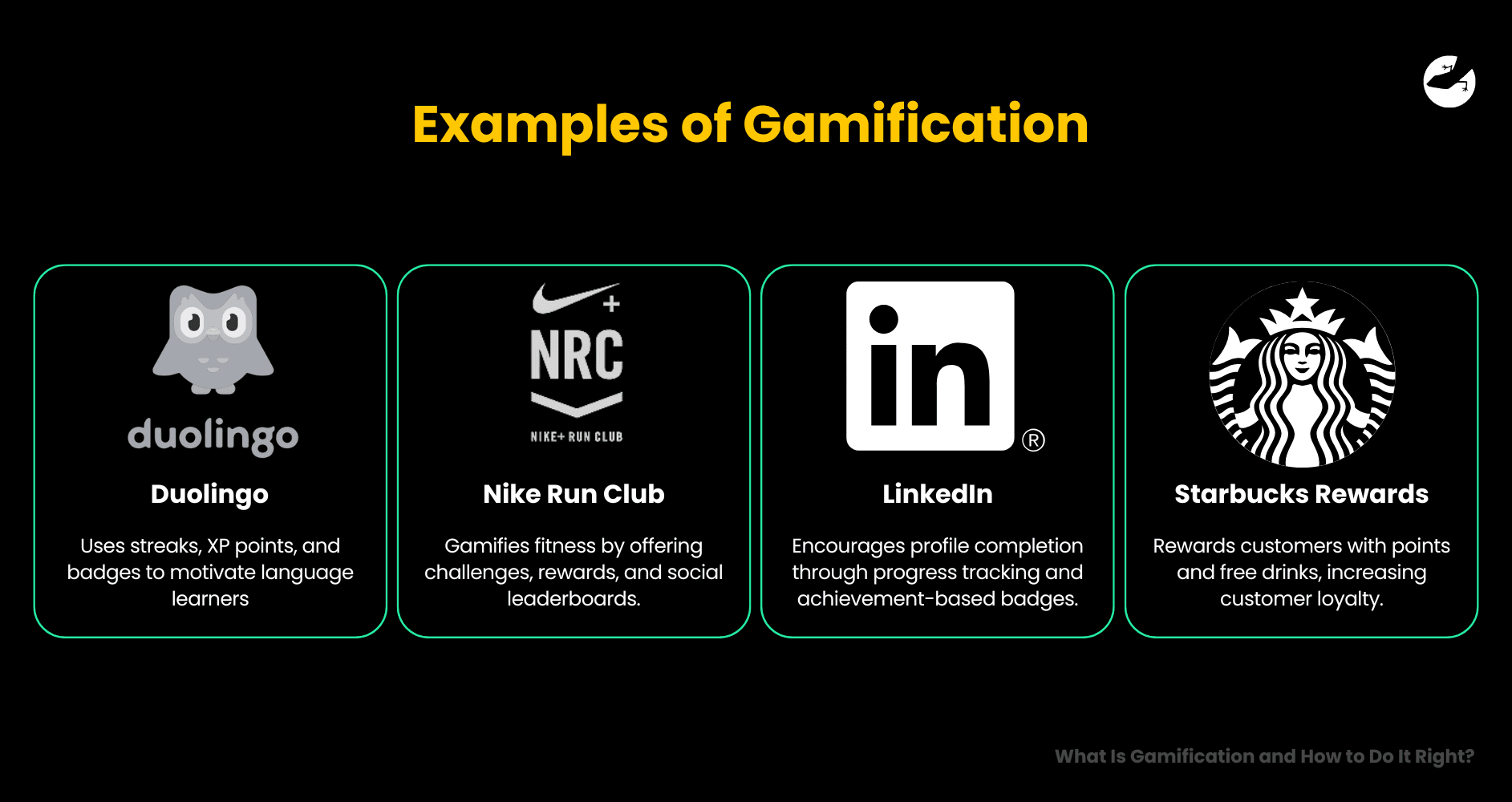
- Duolingo – Uses streaks, XP points, and badges to motivate language learners.
- Nike Run Club – Gamifies fitness by offering challenges, rewards, and social leaderboards.
- LinkedIn – Encourages profile completion through progress tracking and achievement-based badges.
- Starbucks Rewards – Rewards customers with points and free drinks, increasing customer loyalty.
- Salesforce Trailhead – Uses gamified learning to train employees with points, badges, and career progression levels.
Why Gamification Works
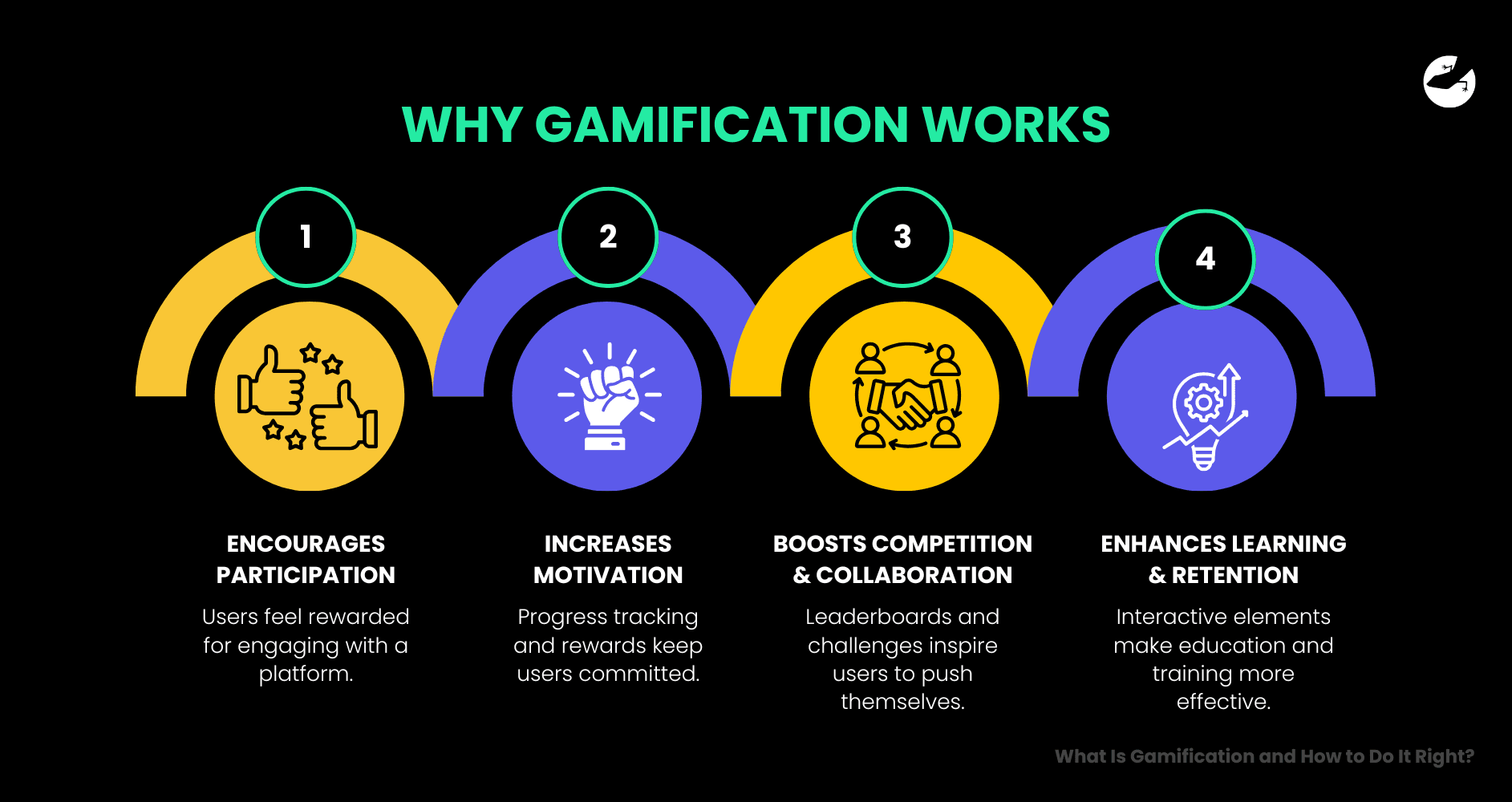
Gamification works because it leverages fundamental human psychology:
- Encourages participation – Users feel rewarded for engaging with a platform.
- Increases motivation – Progress tracking and rewards keep users committed.
- Boosts competition & collaboration – Leaderboards and challenges inspire users to push themselves.
- Enhances learning & retention – Interactive elements make education and training more effective.
When done right, gamification transforms mundane activities into exciting, goal-driven experiences, making users more likely to engage, return, and stay motivated over time.
How to Do Gamification Right
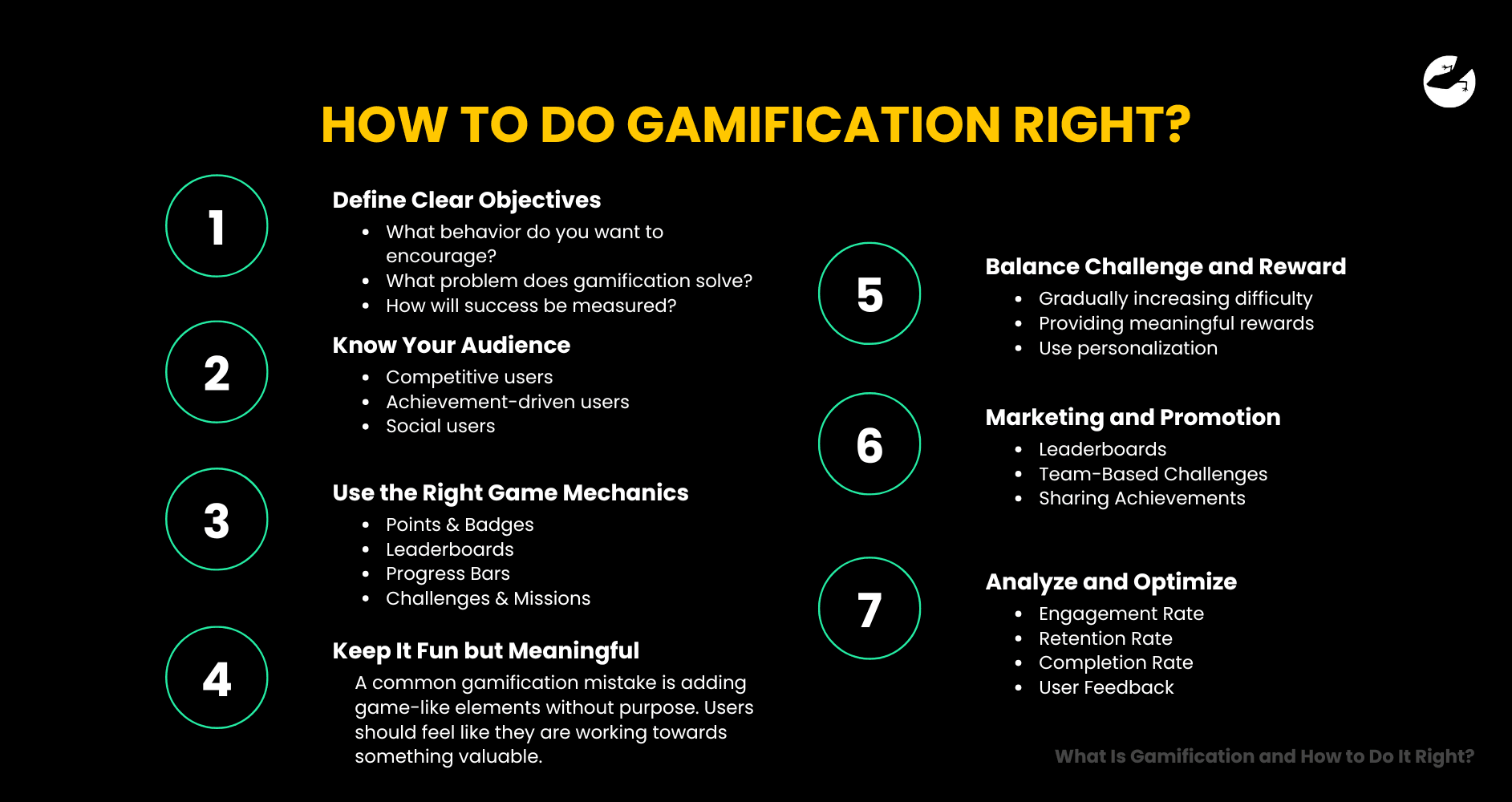
Gamification can be a powerful tool for boosting user engagement, retention, and motivation, but it needs to be implemented strategically to be effective. Simply adding points, badges, or leaderboards without a well-thought-out plan can lead to disengagement or frustration.
To ensure successful gamification, follow these best practices:
1. Define Clear Objectives
Before incorporating gamification into your product or service, ask yourself:
- What behavior do you want to encourage? (e.g., user retention, learning, purchases, productivity)
- What problem does gamification solve? (e.g., lack of motivation, drop-off rates, disengagement)
- How will success be measured? (e.g., increased session times, higher course completion rates, more purchases)
For example, LinkedIn uses gamification to encourage users to complete their profiles. By showing a progress bar, LinkedIn nudges users toward 100% completion, improving profile quality and engagement.
2. Know Your Audience
Gamification should resonate with your target users. Are they competitive? Do they prefer social collaboration? Understanding user psychology is key.
- Competitive users → Respond well to leaderboards and rankings (e.g., Strava).
- Achievement-driven users → Prefer badges and milestones (e.g., Duolingo).
- Social users → Enjoy community-based challenges and team rewards (e.g., Fitbit).
Example: Strava appeals to competitive runners and cyclists by offering leaderboards, challenges, and community-based achievements.
3. Use the Right Game Mechanics
Different game elements work for different goals:
- Points & Badges → Reward users for completing actions (e.g., Fitbit step goals)
- Leaderboards → Encourage friendly competition (e.g., Strava rankings)
- Progress Bars → Keep users motivated to complete tasks (e.g., LinkedIn profile completion)
- Challenges & Missions → Engage users with short-term goals (e.g., Nike Run Club’s monthly challenges)
- Rewards & Incentives → Tangible benefits for participation (e.g., Starbucks Rewards)
Example: Duolingo keeps learners motivated by awarding XP points for completed lessons, tracking progress with streaks, and offering fun in-app rewards like outfits for the Duo Owl mascot.
4. Keep It Fun but Meaningful
A common gamification mistake is adding game-like elements without purpose. Users should feel like they are working towards something valuable rather than completing meaningless tasks.
❌ Wrong Approach: Rewarding users with random badges that have no real impact.
✅ Right Approach: Giving users rewards linked to real achievements or progress.
Example: Fitbit awards users milestone badges (e.g., "100,000 steps walked!") that validate real-world progress, making achievements more rewarding and satisfying.
5. Balance Challenge and Rewarde
If a game is too easy, users will get bored. If it’s too hard, they’ll give up. Find the right balance to keep users engaged without frustration.
Find the sweet spot by:
- Gradually increasing difficulty as users progress.
- Providing meaningful rewards for consistent engagement.
- Using personalization to adjust difficulty based on user behavior.
Example: Nike Run Club’s personalized challenges cater to different fitness levels, keeping runners motivated without overwhelming them.
6. Leverage Social Engagement
Gamification is more powerful when users can compete, collaborate, or share achievements with others. Adding a social element increases motivation and creates a sense of community.
Ways to implement social gamification:
- Leaderboards → Encourage friendly competition (e.g., Strava running challenges).
- Team-Based Challenges → Drive collaboration (e.g., Fitbit step challenges with friends).
- Sharing Achievements → Allow users to show off progress (e.g., Apple Watch activity sharing).
Example: Strava connects runners and cyclists through leaderboards and social sharing, fostering competition and motivation.
7. Analyze and Optimize
Gamification is not a set-it-and-forget-it strategy. Regularly track user behavior, engagement, and feedback to refine the experience.
Key Metrics to Monitor:
- Engagement Rate – Are users interacting with gamification features?
- Retention Rate – Are users returning because of gamification?
- Completion Rate – Are users finishing courses, challenges, or tasks?
- User Feedback – Are users enjoying the experience, or do they find it annoying?
Example: Duolingo constantly tweaks its gamification elements based on user engagement data to improve learning retention.
How Lizard Global Can Help
When done correctly, gamification enhances user engagement, learning, and loyalty. It should be designed with purpose, personalized for users, and continuously optimized based on data. However, poorly executed gamification can feel gimmicky and backfire.
At Lizard Global, we specialize in custom software development and UI/UX strategies that integrate gamification seamlessly into digital products. Whether you're building a mobile app, e-learning platform, or loyalty program, our expert team can help you design engaging and effective gamification strategies tailored to your goals.

Ready to level up your digital experience? Contact us today and let’s bring your gamification vision to life!



